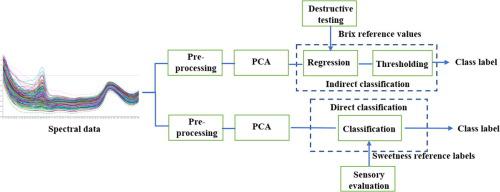Infrared Physics & Technology ( IF 3.3 ) Pub Date : 2021-01-21 , DOI: 10.1016/j.infrared.2021.103645 Ayesha Zeb , Waqar S. Qureshi , Abdul Ghafoor , Amanullah Malik , Muhammad Imran , Javaid Iqbal , Eisa Alanazi

|
Melons are nutritious, healthy, and one of the most eatable summer fruits in South Asia, especially in Pakistan. A melon is delicious if it is sweet, however, the gauge of its sweetness depends on the individual taste buds. In this paper, a direct sweetness classifier is proposed as a quantitative measure, to predict the sweetness of melon as opposed to indirect measure of soluble solid content (SSC/°Brix) based thresholding for near-infrared (NIR) spectroscopy. To provide guidance for fruit sweetness classification, sensory test was conducted, and sweetness standards were established as; very sweet (with °Brix over 10), sweet (with °Brix between 7 and 10), and flat (with °Brix below 7) class. NIR spectral data obtained using F-750 produce quality meter (310–1100 nm) was analyzed to build SSC prediction model and direct sweetness classification model. The best SSC model was obtained using multiple linear regression on second derivative of spectral data (for wavelength range 729–975 nm) with correlation coefficient = 0.93, and root mean square error = 1.63 on test samples. Sweetness of test samples were obtained using °Brix thresholding with an accuracy of 55.45% for three classes. The best direct sweetness classifier was obtained using K nearest neighbor (KNN) on second derivative of spectral data (for wavelength range 729–975 nm) with an accuracy of 70.3% for three classes on test samples. It was further observed that classification accuracy for sweet and flat melon can be improved by combining sweet and very sweet class samples into one ‘satisfactory’ class (with °Brix over 7). For °Brix thresholding-based classification the accuracy was improved to 80.2% and for KNN based direct sweetness classification the accuracy was improved to 88.12%. Extensive evaluation validates our argument that modeling a direct sweetness classifier is a better approach as compared to °Brix based thresholding for sweetness classification using NIR spectroscopy.
中文翻译:

这瓜甜吗?近红外光谱的定量分类
甜瓜营养丰富,健康,是南亚(尤其是巴基斯坦)最可食用的夏季水果之一。甜瓜如果甜,就很好吃,但是甜度的大小取决于各个味蕾。在本文中,提出了一种直接甜度分类器作为定量方法,以预测瓜的甜度,而不是基于可溶固体含量(SSC /°Brix)的基于近红外(NIR)阈值的间接测量。为进行水果甜度分类提供指导,进行了感官测试,并建立了甜度标准;非常甜(糖度在10以上),甜(糖度在7至10之间)和平坦(糖度在7以下)。分析使用F-750生产质量仪(310–1100 nm)获得的NIR光谱数据,以建立SSC预测模型和直接甜度分类模型。最佳SSC模型是通过对光谱数据的二阶导数(波长范围为729–975 nm)进行多元线性回归获得的,相关系数= 0.93,均方根误差= 1.63。使用三级白利糖度阈值获得测试样品的甜度,准确度为55.45%。最佳直接甜度分类器是使用光谱数据的二阶导数(波长范围729-975 nm)上的K最近邻(KNN)获得的,对于三个类别的测试样品,其准确度为70.3%。进一步观察到,通过将甜味和非常甜味的样本合并为一个“令人满意”的类别(白利糖度超过7),可以提高甜瓜和扁瓜的分类精度。对于基于°Brix阈值的分类,准确度提高到80.2%,对于基于KNN的直接甜度分类,准确度提高到88.12%。广泛的评估证实了我们的观点,即与基于°Brix的使用NIR光谱进行甜度分类的阈值阈值相比,对直接甜度分类器进行建模是一种更好的方法。



























 京公网安备 11010802027423号
京公网安备 11010802027423号